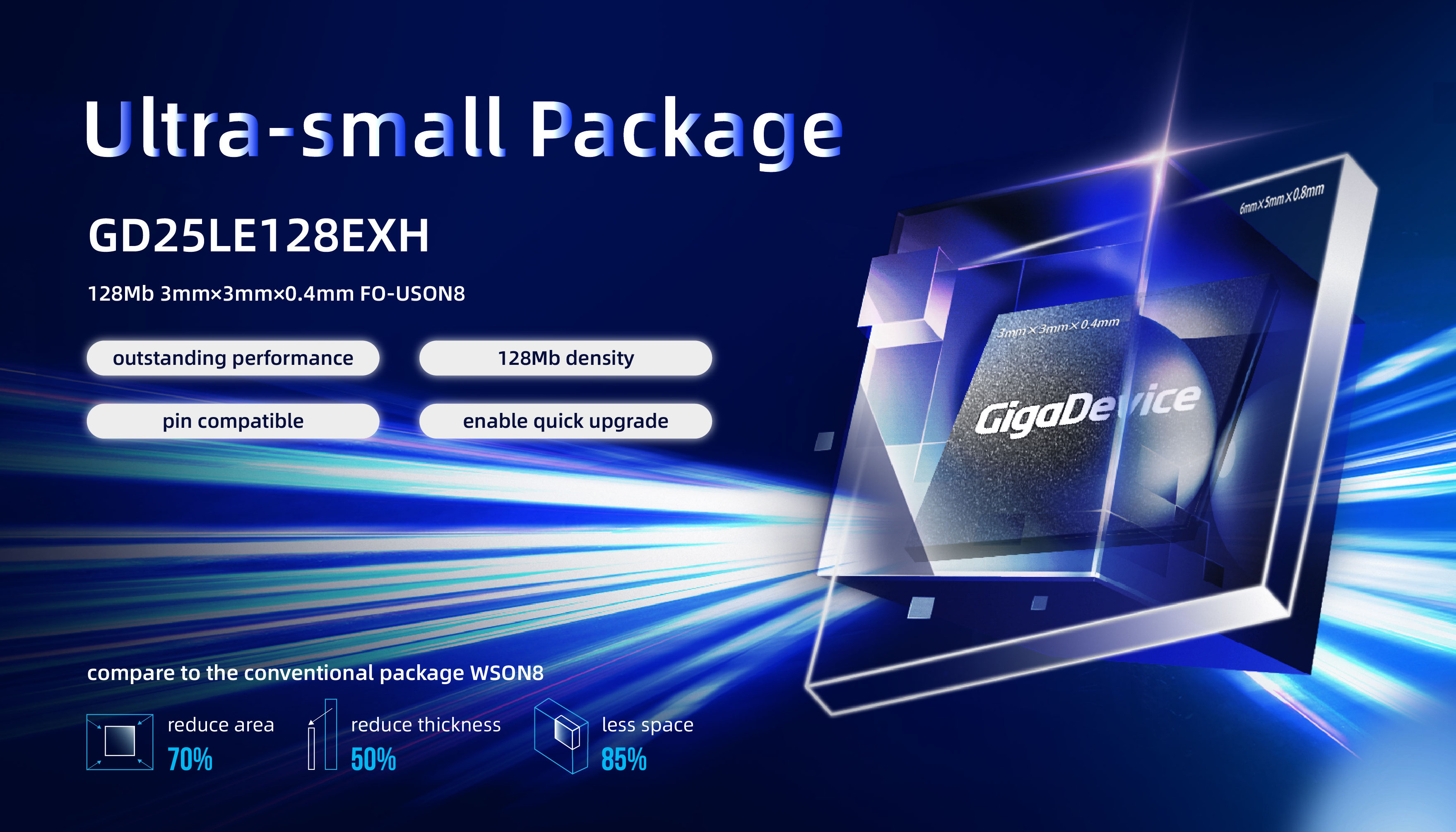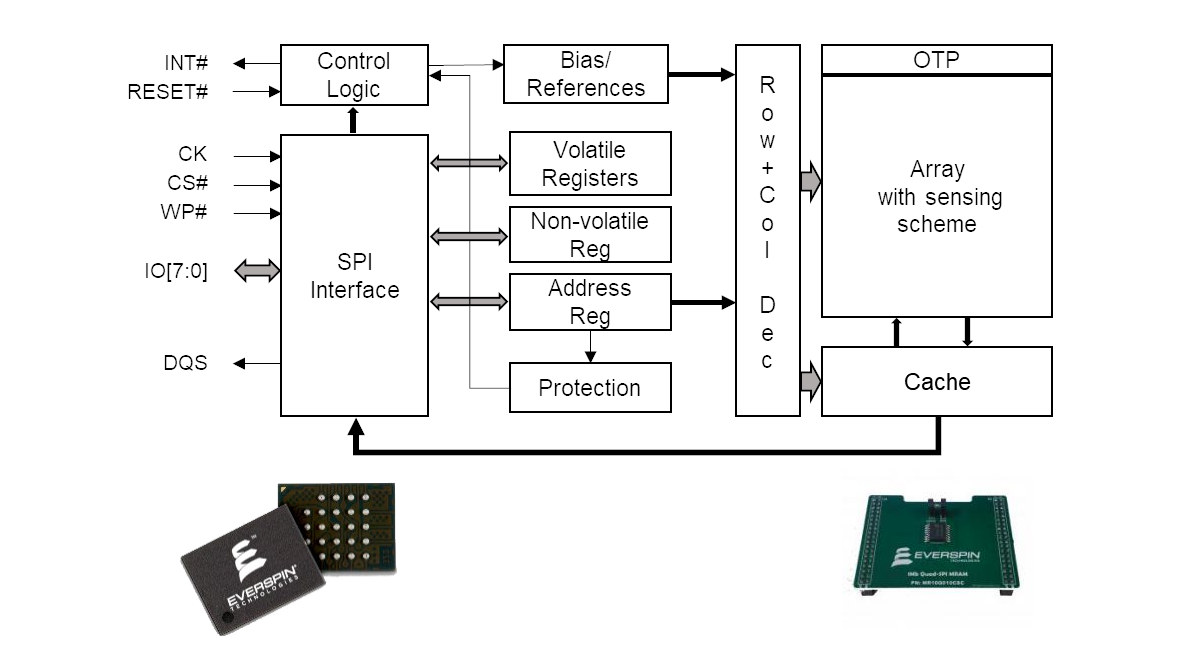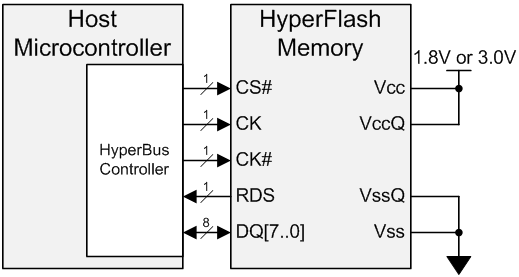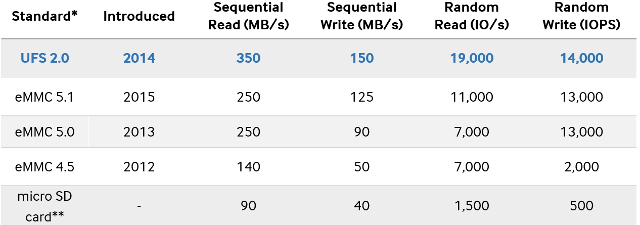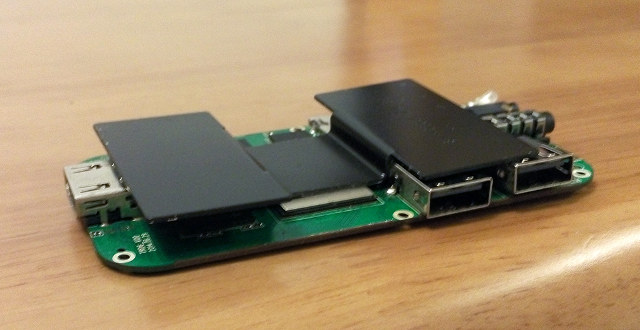GigaDevice Semiconductor has just launched the GD25LE128EXH 128Mbit SPI NOR Flash in a tiny ultra-compact 3x3x0.4mm FO-USON8 package designed for IoT, wearables, healthcare, and networking products. The GD25LE128EXH supports up to 133MHz frequency with four channels delivering up to 532Mbit/s data throughput. GigaDevice also highlights the low power consumption of just 6mA when reading, or a reduction of power consumption by 45% compared to previous devices. GD25LE128EXH specifications: Density – 128Mb I/O Bus – Single I/O, Dual I/O, Quad I/O, QPI Frequency – 133 MHz (x1 x2 x4) Features H/W RESET WP# Security Registers with OTP Locks Suspend Unique ID HOLD# Voltage – 1.65V~2.0V Package – FO-USON8 3x3mm Temperature Range – -40°C~85°C; -40°C~105°C, or -40°C~125°C The GD25LE128E SPI flash is also available in SOP8 208mil, USON8 4x4mm, WSON8 6x5mm, WSON8 8x6mm, and WLCSP (4-4 ball array) packages, which means the GD25LE128EXH’s FO-USON8 package reduces area by 70% and thickness by […]
xSPI MRAM provides an alternative to SPI NOR/NAND flash with up to 400MB/s R/W bandwidth
Everspin has unveiled the EMxxLX xSPI MRAM (Magnetoresistive Random Access Memory) non-volatile memory solution for industrial IoT and embedded systems providing an alternative to SPI NOR/NAND flash with much faster R/W data rates of up to 400MB/s and densities between 8Mbit and 64Mbit. The higher speed is made possible by the new JEDEC expanded Serial Peripheral Interface (xSPI) standard interface and a clock frequency of up to 200 MHz, the maximum supported by the xSPI standard. All chips operate at 1.8V, and the family is offered in 24-ball BGA and 8-pin DFN packages. EMxxLX xSPI MRAM key features and specifications: Density – 8Mb, 16Mb, 32Mb, 64Mb 400MBps sustained throughput with OSPI at 200MHz, DTR, for reads and writes Expanded SPI (xSPI) bus interface supporting Octal, Quad, Dual, and Single SPI protocol Up to 200MHz single and double transfer rate (STR/DTR) for Octal SPI Up to 133MHz, SPI, DSPI, QSPI Data […]
Octo SPI / HyperBus Interface is Designed for High Speed Serial Flash, RAM, and MCP
So far, if you needed high speed storage with low pin count in your MCU based board, you could use QSPI (Quad SPI) NOR flash, but earlier this month I wrote about STM32L4+ MCU family, which added two Octo SPI interfaces. I had never heard about Octo SPI previously. Those two interfaces can be used with single, dual, quad, or octal SPI compatible serial flash or RAM, and support a frequency of up to 86 MHz for Octal SPI memories in STM32L4+ MCU. STMicro OctoSPI interface also supports Cypress/Spansion Hyperbus mode to connect to HyperFlash or HyperRAM chip, or even HyperFlash + HyperRAM Multi-Chip packages (MCP), and variable or fixed external memory latency as defined by the Hyperbus protocol specification. The latter reveals Hyperbus supports performance up to 400 MB/s (provided the controller support 200 MHz), and relies on either 11 bus signals using 3.0V I/O (Single-ended clock CK), or […]
Samsung Introduces Faster Full-Duplex UFS 2.0 Storage for Mobile Devices
eMMC (embedded multimedia card) provides a boost in read and write performance compared to traditional NAND flash memories, let alone micro SD cards. Samsung has now announced the manufacturing of the first 32, 64, and 128GB embedded memory solution based on Universal Flash Storage (UFS) 2.0 standard delivering up to 350MB/s read speed and 150MB/s write speed, or 40% improvement in read speed over eMMC 5.1.This should help further reduce boot time, and app loading times. Moreover, while eMMC read and write operating are sequential (half-duplex), UFS 2.0 allows for full-duplex operating, meaning writing and reading can happen at the same time. UFS can achieve this feat thanks to a LVDS (Low-Voltage Differential Signaling) serial interface with dedicated read/write paths contrary to the parallel 8-bit interface used for eMMC. Combined with a Command Queue(CQ), which sorts out the commands that needs to be carried out, UFS 2.0 allows three times […]
Android 4.4 and Ubuntu 14.10 Tested on Ugoos UM3 mini PC (Rockchip RK3288)
A few days ago I posted pictures of Ugoos UM3, a cute mini PC powered by Rockchip RK3288 quad core Cortex A17 processor, with 2GB RAM, 8GB internal storage, a few USB ports, and Wi-Fi 802.11 b/g/n/ac connectivity. There are so many Rockchip RK3288 based TV boxes and sticks on the market, that it has become difficult to differentiate, so Ugoos has decided to support not only Android 4.4 like all their competitors, but also Ubuntu 14.10, and they’ve provided an alpha release of dual boot Android / Ubuntu images for Ugoos UT3 and UM3 models. Yesterday, I flashed the latest Android/Ubuntu firmware for UM3, and tested the image, so today I can report my findings. First of all, I’d like to point out that I received an earlier sample with various flaws that I reported to Ugoos, and they’ve already committed to fixes: 5V/2A power adapter is not powerful […]
Selecting the Best Adobe Flash Player in Linux for x86 and ARM
I’ve had countless and recurrent crashes caused by Adobe flash plugin either in Firefox and Chromium, mainly while playing videos from YouTube or other online video services that still mostly use flash, instead of HTML5. Adobe flash death is certain, but up to now it has been soooo slow, so I doubt that thing will truly die any time soon, and unfortunately it will probably be with us for many years to come. To work around the issue, I started by enabling Youtube HTML5 player, and try to play embedded videos inside YouTube instead of the orignal website. I still had crashes from time to time, and this method did not help with other video services. So I decided to check out what I could do to fix the issue. When you go to http://www.adobe.com/software/flash/about/ you can check your flash version, and Adobe will also list the player version for […]
Adobe Flash Player 11.1 now Supports Android 4.0
Adobe has recently release an update of its Flash Player for Android, which now supports Android 4.0 (ICS). Flash Player 11.1 is available for download on Android market. Android ICS will be the latest Android version with support for flash, as Adobe has announced it would discontinue developing Flash past 11.1 on mobile platforms. Adobe will also release AIR Android 3.1.0.556 and AIR SDK for Android 3.1.0.488 later this week. Adobe AIR is the runtime that enables developers to deploy standalone applications built with HTML, JavaScript, ActionScript, Flex, Adobe Flash Professional, and Adobe Flash Builder across platforms and devices. The update brings Flash to 11.1.112.60, and apart from Android 4.0 support, it does not bring any other new features, security enhancements or bug fixes. Adobe still lists some know issues: Seeking while video is paused will not update the frame on ICS device StageVideo using On2 and Sorenson does not […]
Optimizations for Cheap Flash Media – ELCE 2011
Arnd Bergmann, Linaro (and IBM), explains how NAND flash access can be improved in Linux embedded systems at Embedded Linux Conference Europe 2011. Abstract: Mass storage in embedded systems typically means NAND flash in the form of eMMC, SDHC or similar technologies. Unlike server-class SSDs, these have few optimizations that help reduce write-amplification. This presentation explains the typical shortcomings in this design and how system builders and software developers together can avoid them, in order to get longer life and better performance out of low-end media. You can also download the presentation slides. Jean-Luc Aufranc (CNXSoft)Jean-Luc started CNX Software in 2010 as a part-time endeavor, before quitting his job as a software engineering manager, and starting to write daily news, and reviews full time later in 2011. www.cnx-software.com


